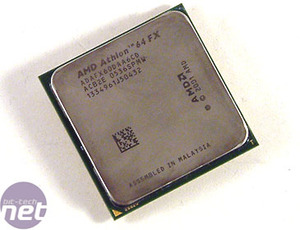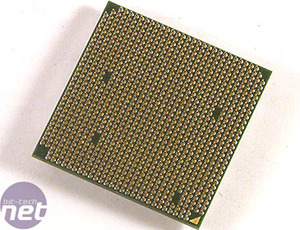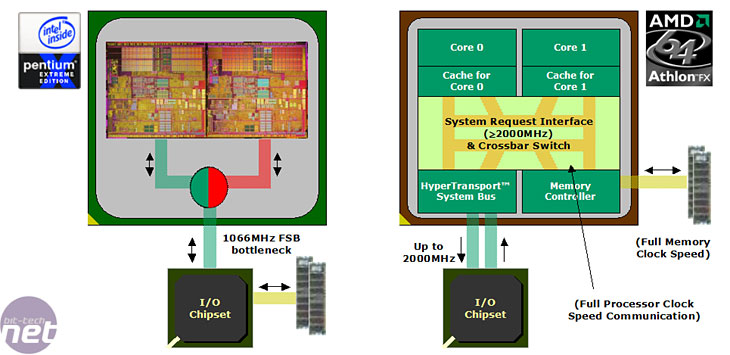
Then towards the end of June, AMD announced its next Athlon 64 FX processor: the FX-57. It was still a single core processor, as dual core support in games didn't really exist at that time. Processors had only been available for four weeks, as AMD announced that the Athlon 64 X2 would be available from the first week in June.


Dual Core Strategies Compared:
On the 27th December, Intel announced its new Pentium Extreme Edition 955, based on the 65 nanometre Presler core. This bought some interesting performance numbers to the table, but it wasn't enough to topple AMD through and through - the Athlon 64 X2 4800+ lost out in very few benchmarks, but the Pentium Extreme Edition 955's strength really showed through during heavy multi-tasking scenarios.Intel has opted to target dual core processors at gamers since the launch of the Pentium Extreme Edition 840. This chip was clocked at 3.2GHz and was pretty woefully under-powered for gaming environments at that point in time. There was nothing to suggest that the Pentium XE 840 was worth considering if you were a gamer. The Pentium XE 955, on the other hand, was a little better at keeping up with the competition, but still not enough to trouble the scorers in gaming scenarios.
On the other hand, AMD was targeting the FX-57 at gamers, while keeping the Athlon 64 X2 in the power user segment of the market. While we don't fully agree with this, as the performance difference at realistic playable settings in games between the fastest Athlon 64 and Athlon 64 X2 was not very large at all, AMD has waited for games to start benefitting from the second processor before it has targeted the Athlon 64 FX at the gamer. In that respect, their move does make a lot of sense.
I guess the problem with Intel's strategy was that they marketed a CPU for power users at gamers. It wasn't quick enough to be labelled Intel's fastest gaming CPU, and I guess that is why Intel were on the receiving end of a lot of criticism when they announced that the Pentium XE 840 would be the successor to the Pentium 4 XE 3.73GHz.
Dual Core Architectures Compared:
Much like the different marketing strategies that AMD and Intel adopted with their dual core processors, they adopted two quite different architectures too.
On the other hand, the two cores on an Athlon 64 X2 talk to each other via the system request interface, which is located on the CPU die. That works at the CPUs operating frequency, which means there is no bottleneck between the two separate cores. Also, the memory controller is located on-die too, which means that requests to the memory controller are direct and don't suffer from increased latencies.
Athlon 64 FX-60:
Where does this put the Athlon 64 FX-60 then?Well, it's clocked at 2.6GHz, and has the same characteristics as every other Athlon 64 X2 - that means there are approximately 223 million transistors on a 90 nanometre SOI die, measuring 199mm² and the CPU has an a TDP of 110W. It also brings the unlocked multiplier over from previous Athlon 64 FX processors. Your motherboard should already fully support the processor, and all you're required to do is flash to the latest available BIOS for your motherboard.
As we noted at the end of our Pentium Extreme Edition 955 review, mult-threaded games are starting to appear - this is the reason why AMD has held off on marketing dual core CPUs at gamers until now. F.E.A.R, City of Villains, Call of Duty 2 and Quake 4 all support multi-threaded code. We've included F.E.A.R. and Quake 4 in our updated CPU testing suite, but we feel this is a subject that requires a closer look - we'll be doing that in the near future.
Lets not waste any more time - it's time to find out how the FX-60 performs...

MSI MPG Velox 100R Chassis Review
October 14 2021 | 15:04






Want to comment? Please log in.